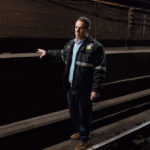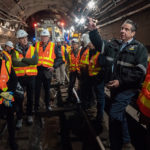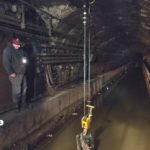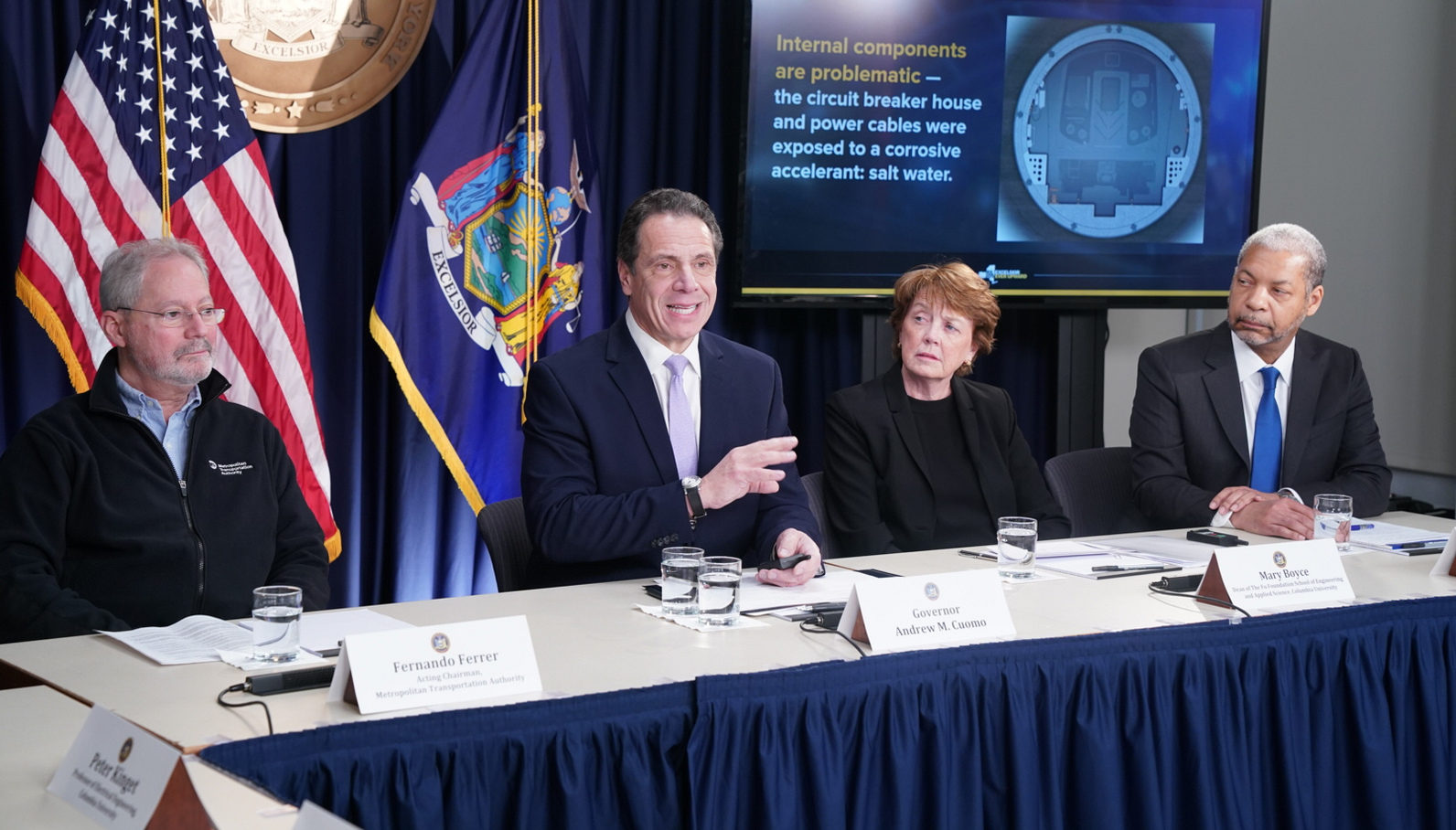
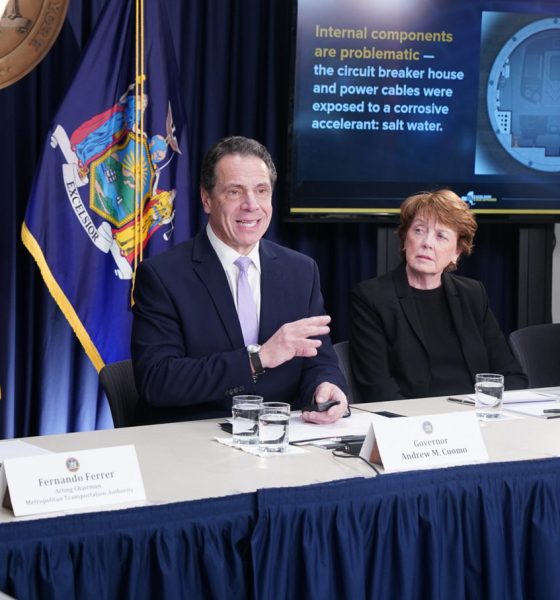
News
NYC subway closure canceled, Elon Musk’s Boring Company tapped for ideas to improve other systems
The Governor of New York State, Andrew Cuomo, announced on Thursday evening that the current plan to shut down the 225,000 commuter-strong L-train tunnel in the New York City public transportation system for a 15-month-long repair process will no longer be necessary due to a plan implementing new reconstruction techniques. After consulting with a panel of expert engineers from Columbia and Cornell Universities, a new design was proposed to be used in the tunnel which would streamline the repair process and require closures during nights and weekends with partial train tunnel service still available. When asked in a conference call Friday whether other innovators such as Elon Musk of Tesla and The Boring Company were consulted, the governor said Musk had not advised on this specific issue, but was consulted on improvements to the subway’s signaling system. The Metropolitan Transport Authority (MTA), New York’s transportation network, accepted the Governor’s panel recommendations following the announcement.
The L train tunnel under the East River connecting Brooklyn and Manhattan in New York, known as the Canarsie Tunnel, was damaged during Hurricane Sandy, the Category 3 major hurricane which affected the entire eastern seaboard of the United States in 2012. Its storm surge hit NYC on October 29, flooding huge portions of the island, including 9 of the 14 underwater tunnels in the city’s transport system. Of these, 6 have already been repaired. According to the MTA, the damage to the Canarsie Tunnel is comparable to tunnel damage experienced on 9/11, underlining the extent of the repairs needed and the reason behind the original required shutdown.
- Governor Andrew Cuomo with engineering consultants surveying the Canarsie Tunnel. | Credit: New York State Governor’s Office
- Governor Andrew Cuomo with engineering consultants surveying the Canarsie Tunnel. | Credit: New York State Governor’s Office
- A graphic representation of the duct banks damaged in the Canarsie Tunnel during Hurricane Sandy. | Credit: MTA
Saltwater flooding in from the East River during Sandy significantly damaged the infrastructure of the 7,100-foot-long tunnel, including tracks, signals, switches, cables, and lighting. The flood waters additionally filled protected cable tube pathways called “duct banks” throughout the tunnel, and once dry, the silt hardened to a cement-like consistency inside them, making it impossible to rip out and restore the damaged components. Canarsie Tunnel also opened in 1924, adding age to the brewing number of problems being amplified by the lingering effects of corrosive saltwater remnants from Sandy.
In 2016, residents were informed the tunnel was possibly going to be shut down for 15 months to address the extensive repairs, causing significant commute challenges for the approximately 225,000 riders depending on the service. The date for service closure was scheduled to begin April 27, 2019, but the impending deadline motivated Governor Cuomo to seek out alternative solutions. “I can’t tell you the number of people in Brooklyn who have looked me right in the eye and said, ‘Are you sure that there is nothing else that can be done and there’s no way you can possibly shorten this?’,” Cuomo stated in a recent press conference announcing the new subway repair plan.
- Damage sustained by the Canarsie Tunnel during Hurricane Sandy. | Credit: MTA
- Damage sustained by the Canarsie Tunnel during Hurricane Sandy. | Credit: MTA
- Damage sustained by the Canarsie Tunnel during Hurricane Sandy. | Credit: MTA
The repair announcement was the end result of a review process Governor Cuomo began on December 14, 2018, wherein he and a consulting team walked through the damaged tunnel to assess the repairs needed first hand. While the plan will take longer than the original project’s timeline – 20 months instead of 15 – the ability to remain open during the repairs is a welcome relief for city residents. The technology that will enable the tunnel to remain open includes wire wrapping along with ultrasound and laser measurement (LIDAR) tools to assess and monitor damage. Engineers from Cornell University’s College of Engineering and Columbia University’s Fu Foundation School of Engineering and Applied Science with expertise in the type of construction involved were the primary sources for the solutions chosen.
Similar to the innovations that came from Musk’s Boring Company tunneling project, the governor has hopes that the unique system planned for the Canarsie Tunnel will inspire other similar repair projects. “This could be a national model because it is a totally different way to reconstruct a tunnel,” Governor Cuomo touted at the press conference. Also, according to the governor, the techniques in the new plan have been implemented in projects in Europe before for bridge repair, but not in tunnel reconstruction. He hopes to bring more out-of-the-box innovations to the city’s transportation as well. In reference to Elon Musk’s companies, he said, “I don’t believe a time where they’re talking about flying cars and you can get into a car and drive 100 miles on the LIE and never touch the steering wheel, that there’s not a better technology that can regulate the trains!”
For more about the announcement and repair plan, watch Governor Cuomo’s press conference below:

Elon Musk
Elon Musk’s X will start using a Tesla-like software update strategy
The initiative seems designed to accelerate updates to the social media platform, while maintaining maximum transparency.

Elon Musk’s social media platform X will adopt a Tesla-esque approach to software updates for its algorithm.
The initiative seems designed to accelerate updates to the social media platform, while maintaining maximum transparency.
X’s updates to its updates
As per Musk in a post on X, the social media company will be making a new algorithm to determine what organic and advertising posts are recommended to users. These updates would then be repeated every four weeks.
“We will make the new 𝕏 algorithm, including all code used to determine what organic and advertising posts are recommended to users, open source in 7 days. This will be repeated every 4 weeks, with comprehensive developer notes, to help you understand what changed,” Musk wrote in his post.
The initiative somewhat mirrors Tesla’s over-the-air update model, where vehicle software is regularly refined and pushed to users with detailed release notes. This should allow users to better understand the details of X’s every update and foster a healthy feedback loop for the social media platform.
xAI and X
X, formerly Twitter, has been acquired by Elon Musk’s artificial intelligence startup, xAI last year. Since then, xAI has seen a rapid rise in valuation. Following the company’s the company’s upsized $20 billion Series E funding round, estimates now suggest that xAI is worth tens about $230 to $235 billion. That’s several times larger than Tesla when Elon Musk received his controversial 2018 CEO Performance Award.
As per xAI, the Series E funding round attracted a diverse group of investors, including Valor Equity Partners, Stepstone Group, Fidelity Management & Research Company, Qatar Investment Authority, MGX, and Baron Capital Group, among others. Strategic partners NVIDIA and Cisco Investments also continued support for building the world’s largest GPU clusters.
News
Tesla FSD Supervised wins MotorTrend’s Best Driver Assistance Award
The decision marks a notable reversal for the publication from prior years, with judges citing major real-world improvements that pushed Tesla’s latest FSD software ahead of every competing ADAS system.

Tesla’s Full Self-Driving (Supervised) system has been named the best driver-assistance technology on the market, earning top honors at the 2026 MotorTrend Best Tech Awards.
The decision marks a notable reversal for the publication from prior years, with judges citing major real-world improvements that pushed Tesla’s latest FSD software ahead of every competing ADAS system. And it wasn’t even close.
MotorTrend reverses course
MotorTrend awarded Tesla FSD (Supervised) its 2026 Best Tech Driver Assistance title after extensive testing of the latest v14 software. The publication acknowledged that it had previously criticized earlier versions of FSD for erratic behavior and near-miss incidents, ultimately favoring rivals such as GM’s Super Cruise in earlier evaluations.
According to MotorTrend, the newest iteration of FSD resolved many of those shortcomings. Testers said v14 showed far smoother behavior in complex urban scenarios, including unprotected left turns, traffic circles, emergency vehicles, and dense city streets. While the system still requires constant driver supervision, judges concluded that no other advanced driver-assistance system currently matches its breadth of capability.
Unlike rival systems that rely on combinations of cameras, radar, lidar, and mapped highways, Tesla’s FSD operates using a camera-only approach and is capable of driving on city streets, rural roads, and freeways. MotorTrend stated that pure utility, the ability to handle nearly all road types, ultimately separated FSD from competitors like Ford BlueCruise, GM Super Cruise, and BMW’s Highway Assistant.
High cost and high capability
MotorTrend also addressed FSD’s pricing, which remains significantly higher than rival systems. Tesla currently charges $8,000 for a one-time purchase or $99 per month for a subscription, compared with far lower upfront and subscription costs from other automakers. The publication noted that the premium is justified given FSD’s unmatched scope and continuous software evolution.
Safety remained a central focus of the evaluation. While testers reported collision-free operation over thousands of miles, they noted ongoing concerns around FSD’s configurable driving modes, including options that allow aggressive driving and speeds beyond posted limits. MotorTrend emphasized that, like all Level 2 systems, FSD still depends on a fully attentive human driver at all times.
Despite those caveats, the publication concluded that Tesla’s rapid software progress fundamentally reshaped the competitive landscape. For drivers seeking the most capable hands-on driver-assistance system available today, MotorTrend concluded Tesla FSD (Supervised) now stands alone at the top.
News
Elon Musk’s Grokipedia surges to 5.6M articles, almost 79% of English Wikipedia
The explosive growth marks a major milestone for the AI-powered online encyclopedia, which was launched by Elon Musk’s xAI just months ago.

Elon Musk’s Grokipedia has grown to an impressive 5,615,201 articles as of today, closing in on 79% of the English Wikipedia’s current total of 7,119,376 articles.
The explosive growth marks a major milestone for the AI-powered online encyclopedia, which was launched by Elon Musk’s xAI just months ago. Needless to say, it would only be a matter of time before Grokipedia exceeds English Wikipedia in sheer volume.
Grokipedia’s rapid growth
xAI’s vision for Grokipedia emphasizes neutrality, while Grok’s reasoning capabilities allow for fast drafting and fact-checking. When Elon Musk announced the initiative in late September 2025, he noted that Grokipedia would be an improvement to Wikipedia because it would be designed to avoid bias.
At the time, Musk noted that Grokipedia “is a necessary step towards the xAI goal of understanding the Universe.”
Grokipedia was launched in late October, and while xAI was careful to list it only as Version 0.1 at the time, the online encyclopedia immediately earned praise. Wikipedia co-founder Larry Sanger highlighted the project’s innovative approach, noting how it leverages AI to fill knowledge gaps and enable rapid updates. Netizens also observed how Grokipedia tends to present articles in a more objective manner compared to Wikipedia, which is edited by humans.
Elon Musk’s ambitious plans
With 5,615,201 total articles, Grokipedia has now grown to almost 79% of English Wikipedia’s article base. This is incredibly quick, though Grokipedia remains text-only for now. xAI, for its part, has now updated the online encyclopedia’s iteration to v0.2.
Elon Musk has shared bold ideas for Grokipedia, including sending a record of the entire knowledge base to space as part of xAI’s mission to preserve and expand human understanding. At some point, Musk stated that Grokipedia will be renamed to Encyclopedia Galactica, and it will be sent to the cosmos.
“When Grokipedia is good enough (long way to go), we will change the name to Encyclopedia Galactica. It will be an open source distillation of all knowledge, including audio, images and video. Join xAI to help build the sci-fi version of the Library of Alexandria!” Musk wrote, adding in a later post that “Copies will be etched in stone and sent to the Moon, Mars and beyond. This time, it will not be lost.”
